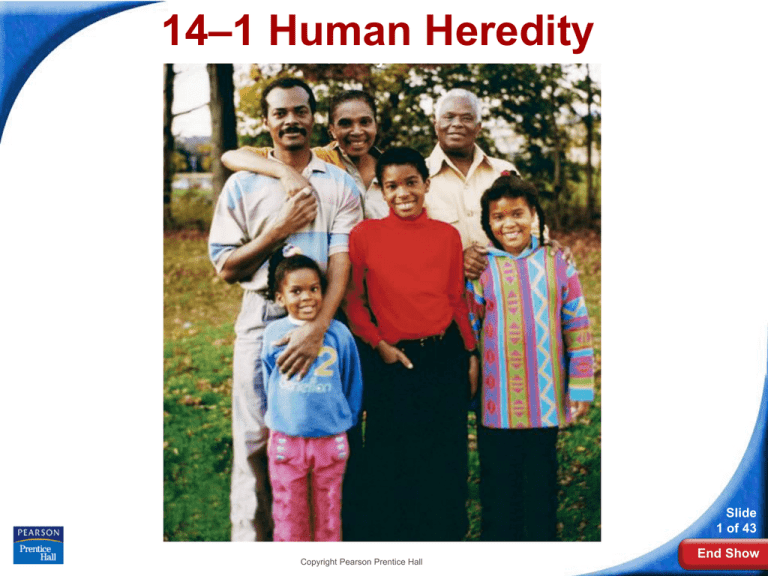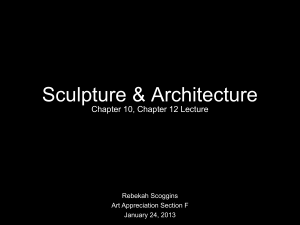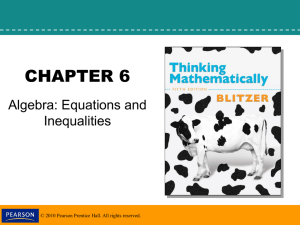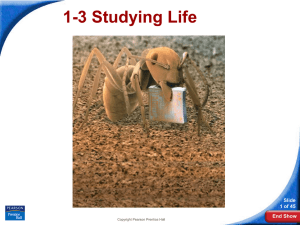
14–1
Human
Heredity
14-1 Human Heredity
Slide
1 of 43
Copyright Pearson Prentice Hall
End Show
Review
• What is a chromosome?
• What is one method
geneticists use to predict
the possible genotypes of
the offspring from a
specific cross?
Slide
2 of 43
Copyright Pearson Prentice Hall
End Show
OBJECTIVES
• Students describe how sex is
determined.
• Students know how to determine
the genotypes of individuals using
a pedigree diagram showing
phenotypes.
• Students know how to predict the
probable mode of inheritance from
a pedigree diagram showing
phenotypes.
Copyright Pearson Prentice Hall
Slide
3 of 43
End Show
14–1 Human Heredity
Human Chromosomes
Human Chromosomes
Cell biologists analyze chromosomes by looking at
karyotypes.
Cells are photographed during mitosis. Scientists
then cut out the chromosomes from the
photographs and group them together in pairs.
A karyotype is a picture of chromosomes matched
in pairs.
Slide
4 of 43
Copyright Pearson Prentice Hall
End Show
14–1 Human Heredity
Human Chromosomes
Human Karyotype
Slide
5 of 43
Copyright Pearson Prentice Hall
End Show
14–1 Human Heredity
Human Chromosomes
Two of the 46 human chromosomes are known as
sex chromosomes, because they determine an
individual's sex.
• Females have two copies of an X chromosome.
• Males have one X chromosome and one Y
chromosome.
The remaining 44 chromosomes are known as
autosomal chromosomes, or autosomes.
Slide
6 of 43
Copyright Pearson Prentice Hall
End Show
14–1 Human Heredity
Human Chromosomes
How is sex determined?
Slide
7 of 43
Copyright Pearson Prentice Hall
End Show
14–1 Human Heredity
Human Chromosomes
All human egg cells carry a single X
chromosome (23,X).
Half of all sperm cells carry an X
chromosome (23,X) and half carry a Y
chromosome (23,Y).
About half of the zygotes will be 46,XX
(female) and half will be 46,XY (male).
Slide
8 of 43
Copyright Pearson Prentice Hall
End Show
14–1 Human Heredity
Human Chromosomes
Males and females are
born in a roughly 50 : 50
ratio because of the
way in which sex
chromosomes
segregate during
meiosis.
Slide
9 of 43
Copyright Pearson Prentice Hall
End Show
14–1 Human Heredity
Human Traits
Human Traits
In order to apply Mendelian genetics to humans,
biologists must identify an inherited trait controlled
by a single gene.
They must establish that the trait is inherited and
not the result of environmental influences.
They have to study how the trait is passed from
one generation to the next.
Slide
10 of 43
Copyright Pearson Prentice Hall
End Show
14–1 Human Heredity
Human Traits
Pedigree Charts
A pedigree chart shows the relationships within a
family.
Genetic counselors analyze pedigree charts to
infer the genotypes of family members.
Slide
11 of 43
Copyright Pearson Prentice Hall
End Show
14–1 Human Heredity
Human Traits
A circle
A horizontal line represents
A shaded
circle or
square
connecting
a male
and
a female.
indicates
thatrepresents
a person a
a female
expresses
the trait.
marriage.
A square
A vertical line and a
represents
a male. bracket connect the
parents to their
children.
A circle or square
that is not
shaded indicates
that a person
does not express
the trait.
Slide
12 of 43
Copyright Pearson Prentice Hall
End Show
14–1 Human Heredity
Human Traits
Genes and the Environment
Some obvious human traits are almost impossible
to associate with single genes.
Traits, such as the shape of your eyes or ears, are
polygenic, meaning they are controlled by many
genes.
Many of your personal traits are only partly
governed by genetics.
Slide
13 of 43
Copyright Pearson Prentice Hall
End Show
14–1 Human Heredity
Human Genes
Human Genes
The human genome includes tens of thousands of
genes.
In 2003, the DNA sequence of the human genome
was published.
In a few cases, biologists were able to identify
genes that directly control a single human trait
such as blood type.
Slide
14 of 43
Copyright Pearson Prentice Hall
End Show
14–1 Human Heredity
Mode of Inheritance
• Recessive: disorders caused by having 2
recessive alleles
• Dominant: disorders caused by having
just 1 dominant allele
• Sex Linked: disorders carried on one of
the sex chromosomes (either X or Y)
Slide
15 of 43
Copyright Pearson Prentice Hall
End Show
14–1 Human Heredity
Human Genes
Recessive Alleles
The presence of a normal, functioning gene is
revealed only when an abnormal or nonfunctioning
allele affects the phenotype.
Many disorders are caused by autosomal
recessive alleles.
Slide
16 of 43
Copyright Pearson Prentice Hall
End Show
14–1 Human Heredity
Human Genes
Slide
17 of 43
Copyright Pearson Prentice Hall
End Show
14–1
Click to Launch:
Continue to:
- or -
Slide
18 of 43
End Show
Copyright Pearson Prentice Hall
14–1
A chromosome that is not a sex chromosome is
know as a(an)
a. autosome.
b. karyotype.
c. pedigree.
d. chromatid.
Slide
19 of 43
End Show
Copyright Pearson Prentice Hall
14–1
Whether a human will be a male or a female is
determined by which
a. sex chromosome is in the egg cell.
b. autosomes are in the egg cell.
c. sex chromosome is in the sperm cell.
d. autosomes are in the sperm cell.
Slide
20 of 43
End Show
Copyright Pearson Prentice Hall
14–1
Mendelian inheritance in humans is typically
studied by
a. making inferences from family pedigrees.
b. carrying out carefully controlled crosses.
c. observing the phenotypes of individual
humans.
d. observing inheritance patterns in other
animals.
Slide
21 of 43
End Show
Copyright Pearson Prentice Hall
END OF SECTION






